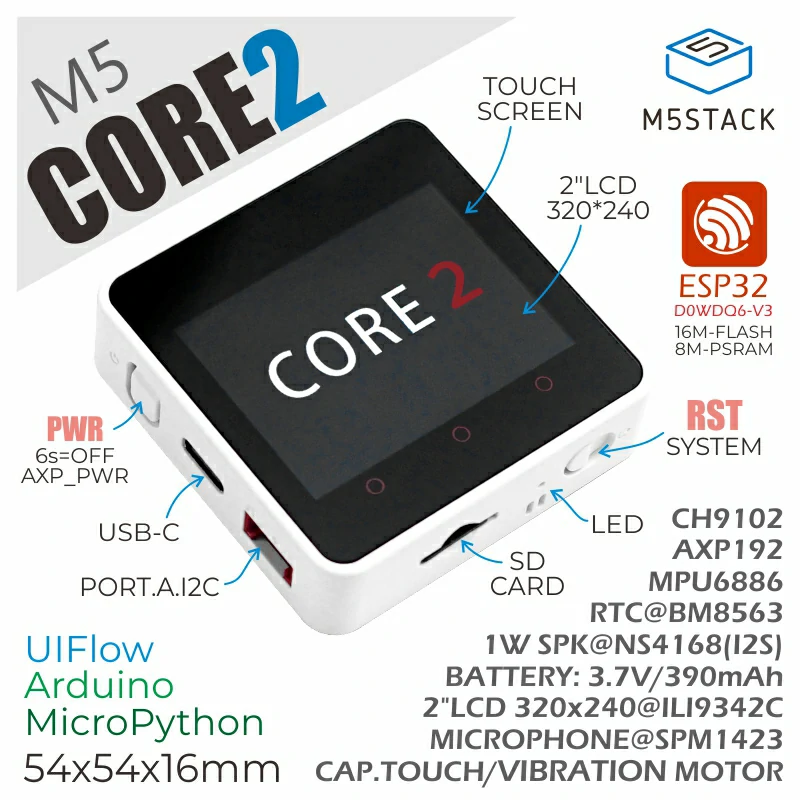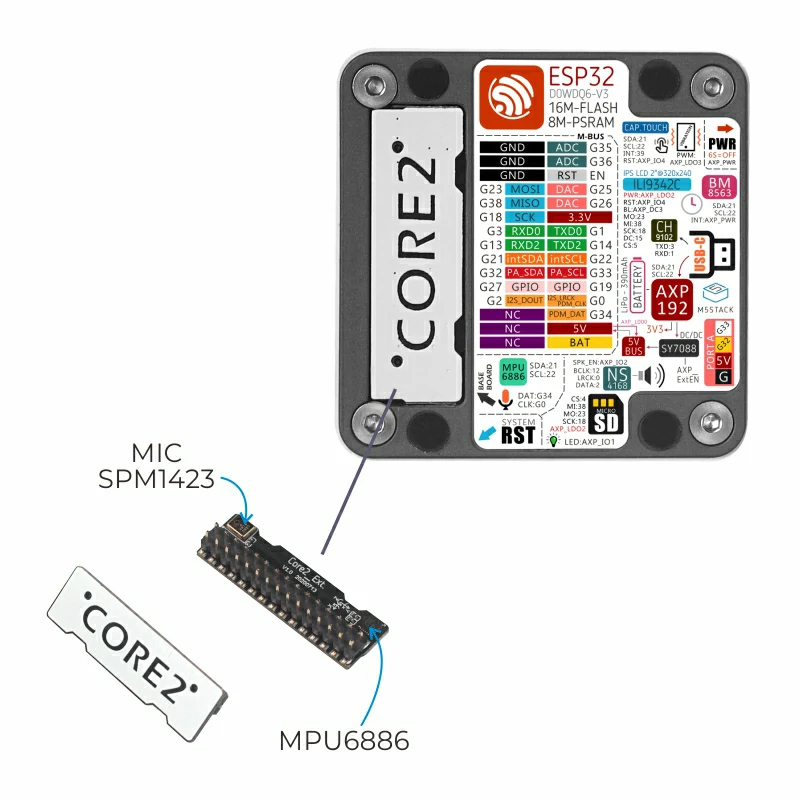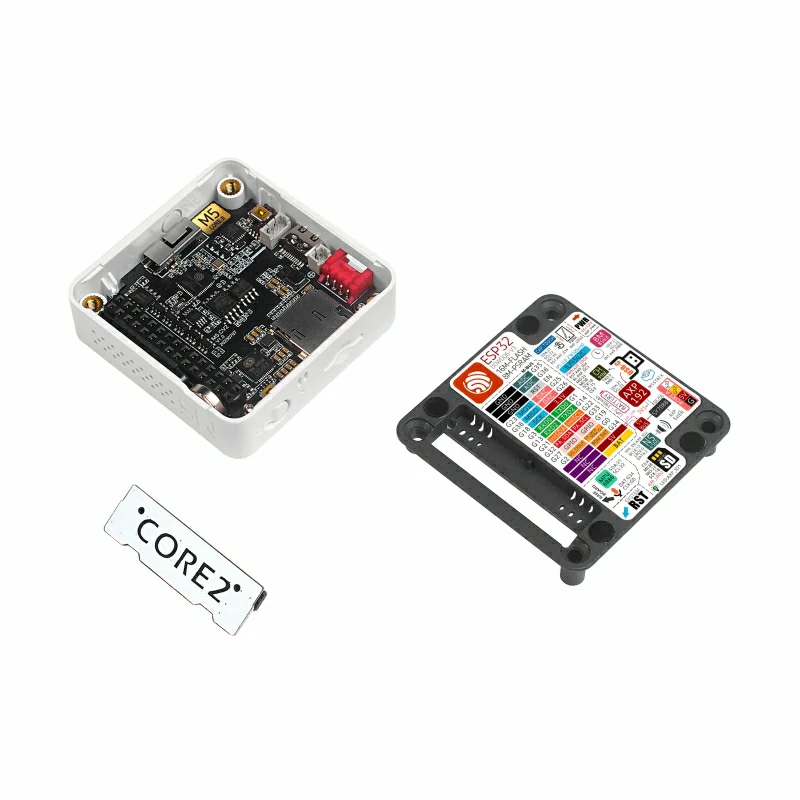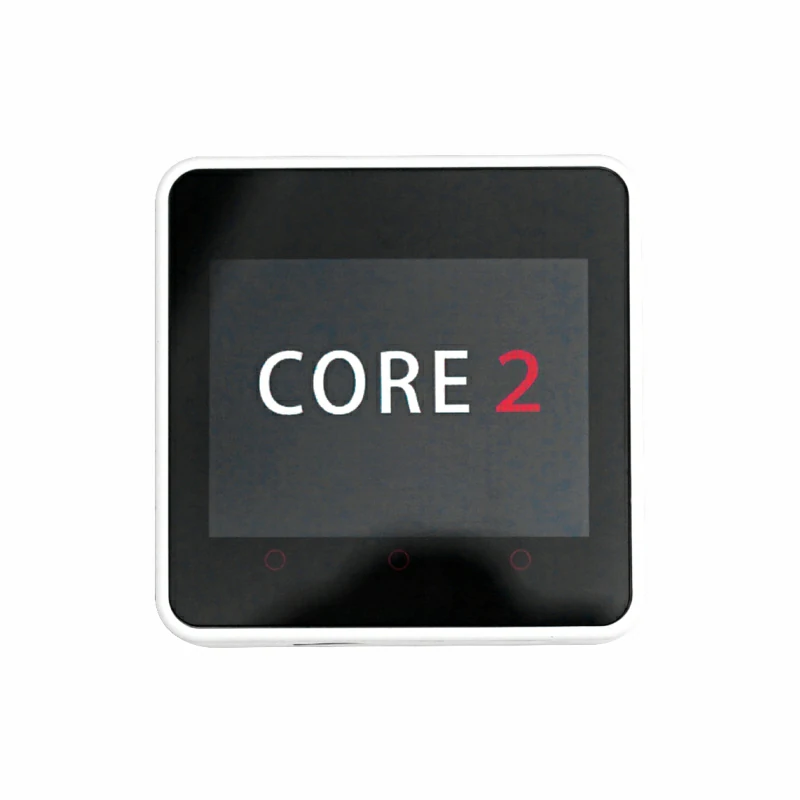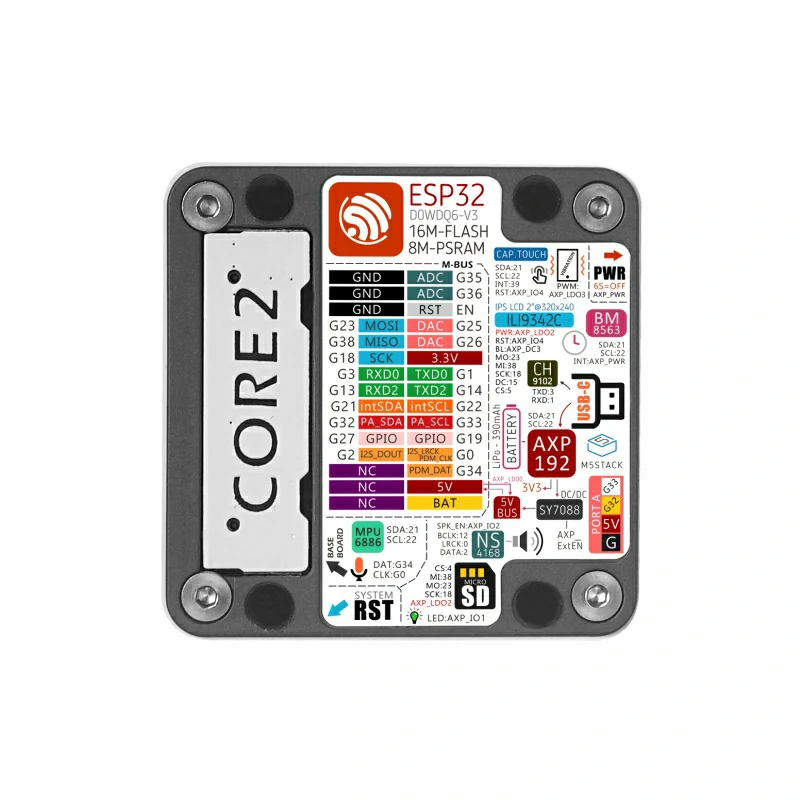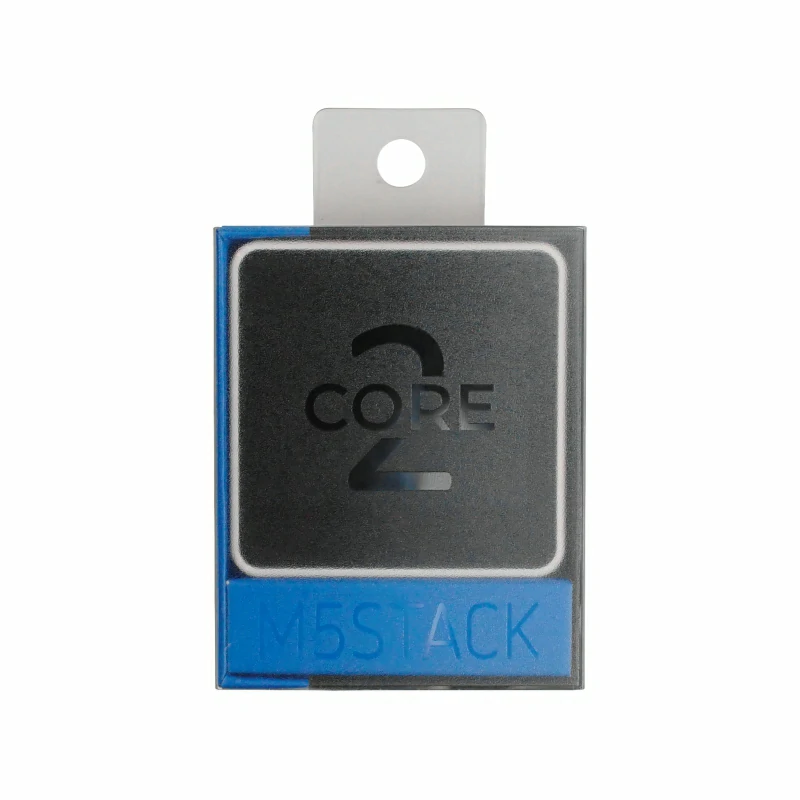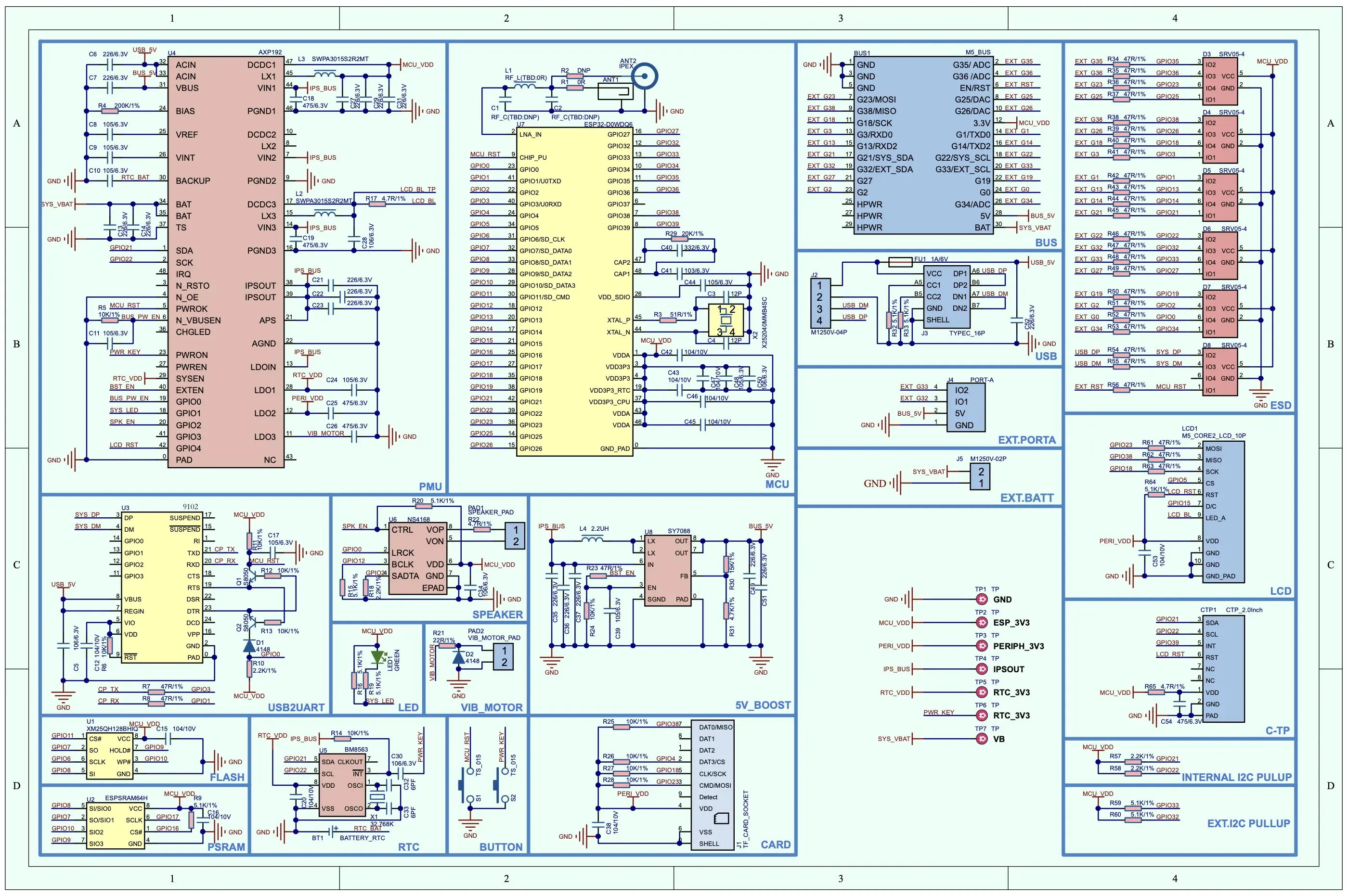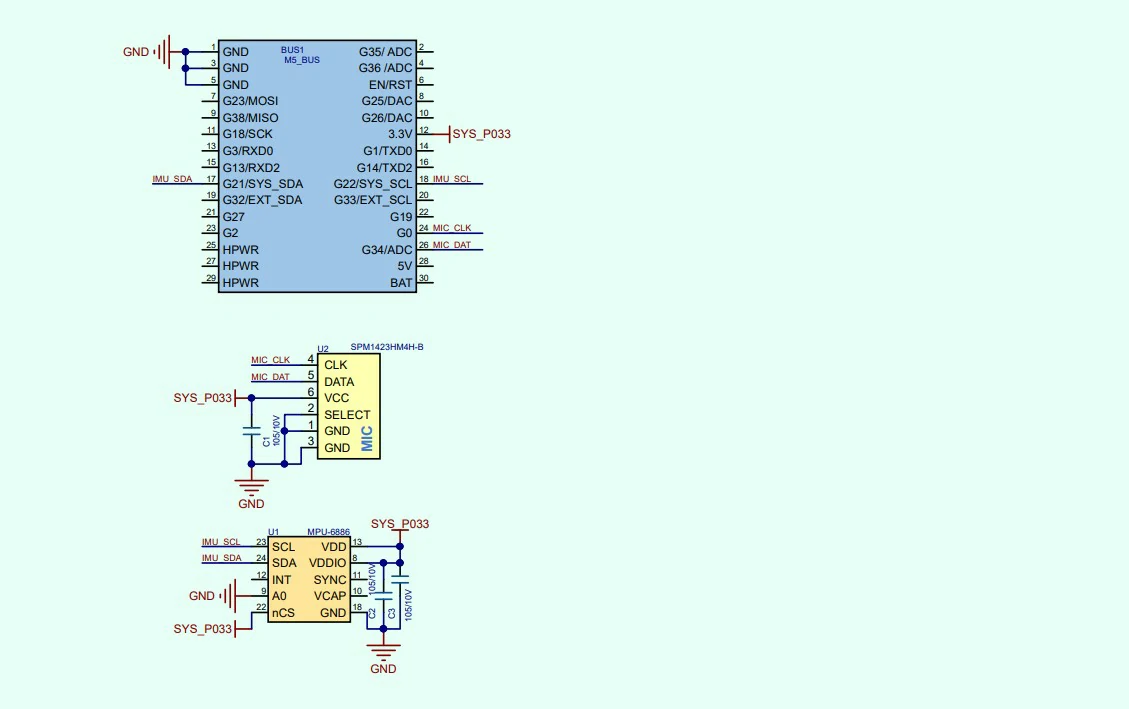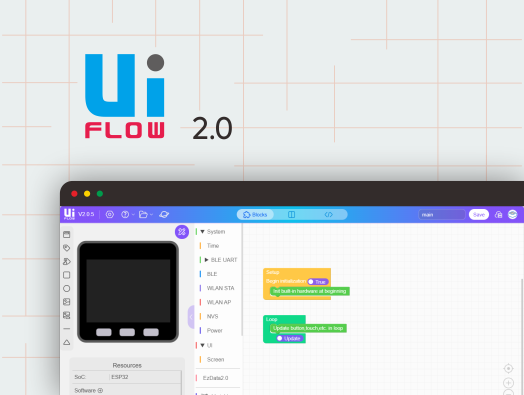Core2
SKU:K010
説明
M5Core2は、M5Stack 開発キットシリーズの第 2 世代のコアデバイスで、オリジナル世代のコアの機能をさらに強化したものです。
MCU はESP32モデル D0WDQ6-V3 で、デュアルコアの Xtensa® 32-bit 240Mhz LX6 プロセッサを搭載し、個別に制御することが可能です。Wi-Fi を標準サポートし、オンボードで 16MB Flash と 8MB PSRAM、充電やプログラムのダウンロード、シリアル通信が可能な USB TYPE-C インターフェース、2.0 インチ内蔵静電容量式タッチパネル、内蔵振動モーターを搭載しています。
また、M5Core2 は、正確なタイミングを提供できる RTC モジュールを内蔵しています。電源は AXP192 電源管理チップによって管理され、ベースの電力消費を効果的に制御することができ、内蔵の緑色 LED 電源インジケータは、ユーザーにバッテリー残量を通知するのに役立ちます。バッテリー容量は 390mAh にアップグレードされ、前モデルよりもはるかに長い時間コアを駆動することができます。
M5Core2 は、TF カード(microSD)スロットとスピーカーを搭載しています。しかし、より高音質なサウンドを出力するために、I2S デジタルオーディオインターフェイスのパワーアンプチップを採用し、信号の歪みを効果的に防止しています。底面左側と底面にそれぞれ独立した電源ボタンとリセットボタンを搭載しています。
前面の 3 つのアイコンは、プログラマブルな静電容量式ボタンです。ベースの背面には、6 軸 IMU センサーとマイクを搭載した小型の拡張ボードがあります。
M5Stack Core2 がサポートする開発プラットフォームとプログラミング言語。Arduino, UIFlow (Blockly、MicroPython 言語使用) あなたの開発スキルやプログラミングスキルに関係なく、M5Stack はあなたのアイデアを徐々に現実のものにするお手伝いをします。
クイックスタート
本教程将向你介绍,如何通过 UIFlow 图形化编程平台控制 M5Core2 设备
本教程将向你介绍,如何通过 UiFlow2 图形化编程平台控制 M5Core2 设备
本教程将向你介绍,如何通过 Arduino IDE 编程控制 M5Core2 设备
特徴
- ESP32-based, Bluetooth/Wi-Fi を内蔵
- 16M Flash,8M PSRAM
- スピーカー、電源 LED、バイブレーションモーター、RTC、I2S アンプ、静電容量タッチスクリーン、電源ボタン、リセットボタンを内蔵
- TF card スロット (最大 16GB)
- 電源管理 IC で管理されたリチウムイオンバッテリーを内蔵
- 独立した小さな基板上に 6 軸 IMU と PDM マイクを搭載しています
- M-Bus Socket & Pins
- 複数の開発プラットフォームを利用できます:
- UiFlow1
- UiFlow2
- Arduino IDE
- ESP-IDF
- PlatformIO
含まれるもの
- 1x M5Stack Core2
- 1x Type-C USB ケーブル(20cm)
- 1x 六角レンチ
アプリケーション
- IoT コントローラー
- STEM 教育製品
- DIY プロジェクト
- スマートホーム構築
仕様
| Resources | Parameter |
|---|
| SoC | ESP32-D0WDQ6-V3, 240MHz dual core,600 DMIPS,520KB SRAM,Wi-Fi |
| Flash | 16MB |
| PSRAM | 8MB |
| Input Voltage | 5V @ 500mA |
| Interface | TypeC x 1, GROVE(I2C+I/O+UART) x 1 |
| 液晶スクリーン | 2.0"@320*240 IPS ILI9342C |
| タッチスクリーン制御 IC | FT6336U |
| スピーカー | 1W-092 |
| LED | Green power indicator light |
| ボタン | Power button, RST button, Virtual screen button*3 |
| Vibration reminder | Vibration motor |
| マイク | SPM1423 |
| I2S アンプ | NS4168 |
| 6 軸 IMU | MPU6886 |
| RTC | BM8563 |
| PMU | AXP192 |
| USB Chip | CP2104/CH9102F (two chip versions, there is no difference in function and use) |
| DC-DC Boost | SY7088 |
| TF card スロット | 16G Max |
| リチウムイオンバッテリー | 390mAh @ 3.7V |
| アンテナ | 2.4G 3D antenna |
| 動作温度 | 0°C to 60°C |
| Base screw specifications | Hexagon socket countersunk head M3 |
| Internal PCB board reserved interface | Battery interface (specification: 1.25mm-2P)
USB line interface (specification: 1.25mm-4P) |
| カバー素材 | Plastic ( PC ) |
| 製品サイズ | 54.0 x 54.0 x 16.5mm |
| 製品重量 | 54.9g |
| 梱包サイズ | 80.0 x 59.9 x 21.6mm |
| 梱包重量 | 100.8g |
操作説明
電源管理
電源操作:
電源オン: 左側の電源ボタンを一回押します。
電源オフ: 左側の電源ボタンを 6 秒間長押しします。
リセット: 底面の RST ボタンを一回押します。
注意事項
M5Core2 を M5 モジュールとスタックする場合、Core2 のバッテリーボトムを取り外す必要があります。ベースの I2S マイク、IMU、およびバッテリー機能を保持しながら他のモジュールをスタックしたい場合は、M5GO Bottom2 の使用をお勧めします。 Core2 の PCB は、CP2104 チップとリチウムバッテリー接続のインターフェースを予約しています。
M5Core2 内蔵の振動モーターは M5 Base シリーズのベースと構造的に干渉します。デバイスを損傷しないように、M5Core2 を M5 Base シリーズの機能ベースとスタックしないでください。
一部の画面端ではタッチの非線形性の問題が発生する場合があります。この問題を解決するには、
M5Tool を使用して画面ファームウェアをアップグレードしてみてください。
認証
回路図
ピンマップ
LCD & TF card
LCD :320x240
TF card Maximum size 16GB
| ESP32-D0WDQ6-V3 | GPIO38 | GPIO23 | GPIO18 | GPIO5 | GPIO15 |
|---|
| ILI9342C | MISO | MOSI | SCK | CS | DC |
| AXP192 | AXP_IO4 | AXP_DC3 | AXP_LDO2 |
|---|
| ILI9342C | RST | BL | PWR |
TF Card
| ESP32-D0WDQ6-V3 | GPIO38 | GPIO23 | GPIO18 | GPIO4 |
|---|
| TF Card | MISO | MOSI | SCK | CS |
CAP.TOUCH (I2C Addr: 0x38)
| ESP32-D0WDQ6-V3 | GPIO21 | GPIO22 | GPIO39 |
|---|
| FT6336U | SDA | SCL | INT |
| AXP192 | AXP_IO4 |
|---|
| FT6336U | RST |
Mic & NS4168(Speaker)
| ESP32-D0WDQ6-V3 | GPIO12 | GPIO0 | GPIO2 | GPIO34 |
|---|
| NS4168 | BCLK | LRCK | DATA | |
| Mic | | CLK | | DATA |
| AXP192 | AXP_IO2 |
|---|
| NS4168 | SPK_EN |
AXP Power Indicator Light
| AXP192 | AXP_IO1 | AXP_LDO3 |
|---|
| Green LED | Vcc | |
| Vibration motor | | Vcc |
RTC
| ESP32-D0WDQ6-V3 | GPIO21 | GPIO22 |
|---|
| BM8563 | SDA | SCL |
IMU
| ESP32-D0WDQ6-V3 | GPIO21 | GPIO22 |
|---|
| MPU6886 | SDA | SCL |
USB to serial chip
| ESP32-D0WDQ6-V3 | GPIO1 | GPIO3 |
|---|
| CP2104/CH9102F | RXD | TXD |
Internal I2C connection
| ESP32-D0WDQ6-V3 | GPIO21 | GPIO22 |
|---|
| MPU6886 | SDA | SCL |
| AXP192 | SDA | SCL |
| BM8563 | SDA | SCL |
| FT6336U | SDA | SCL |
HY2.0-4P
| HY2.0-4P | 黒 | 赤 | 黄 | 白 |
|---|
| PORT.A | GND | 5V | G32 | G33 |
| PORT.B | GND | 5V | G26 | G36 |
| PORT.C | GND | 5V | G13 | G14 |
M5Core2 M-BUS ピンレイアウト
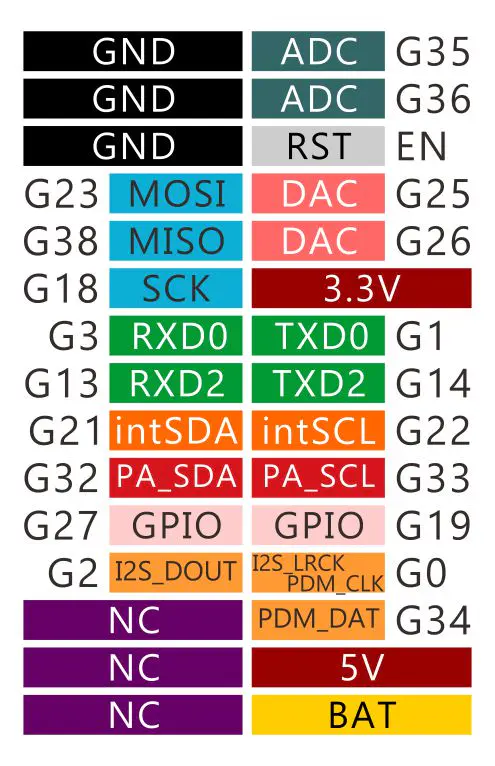
M5Core2 BUS(compared to M5Stack)

M5PORT 定義
| PORT | PIN | Note: |
|---|
| PORT-A(Red) | 32/33 | I2C |
| PORT-B(Black) | 26/36 | DAC/AD |
| PORT-C(Blue) | 13/14 | UART |
ESP32 ADC/DAC
| ADC1 | ADC2 | DAC1 | DAC2 |
|---|
| 8 channels | 10 channels | 2 channels | 2 channels |
| G32-39 | G0/2/4/12-15/25-27 | G25 | G26 |
For more information about Pin assignment and Pin Remapping, Please refer to ESP32 Datasheet
Charging current measured value
| charging current | Fully charged current(Power OFF) | Fully charged current(Power ON) |
|---|
| 0.219A | 0.055A | 0.147A |
製品サイズ
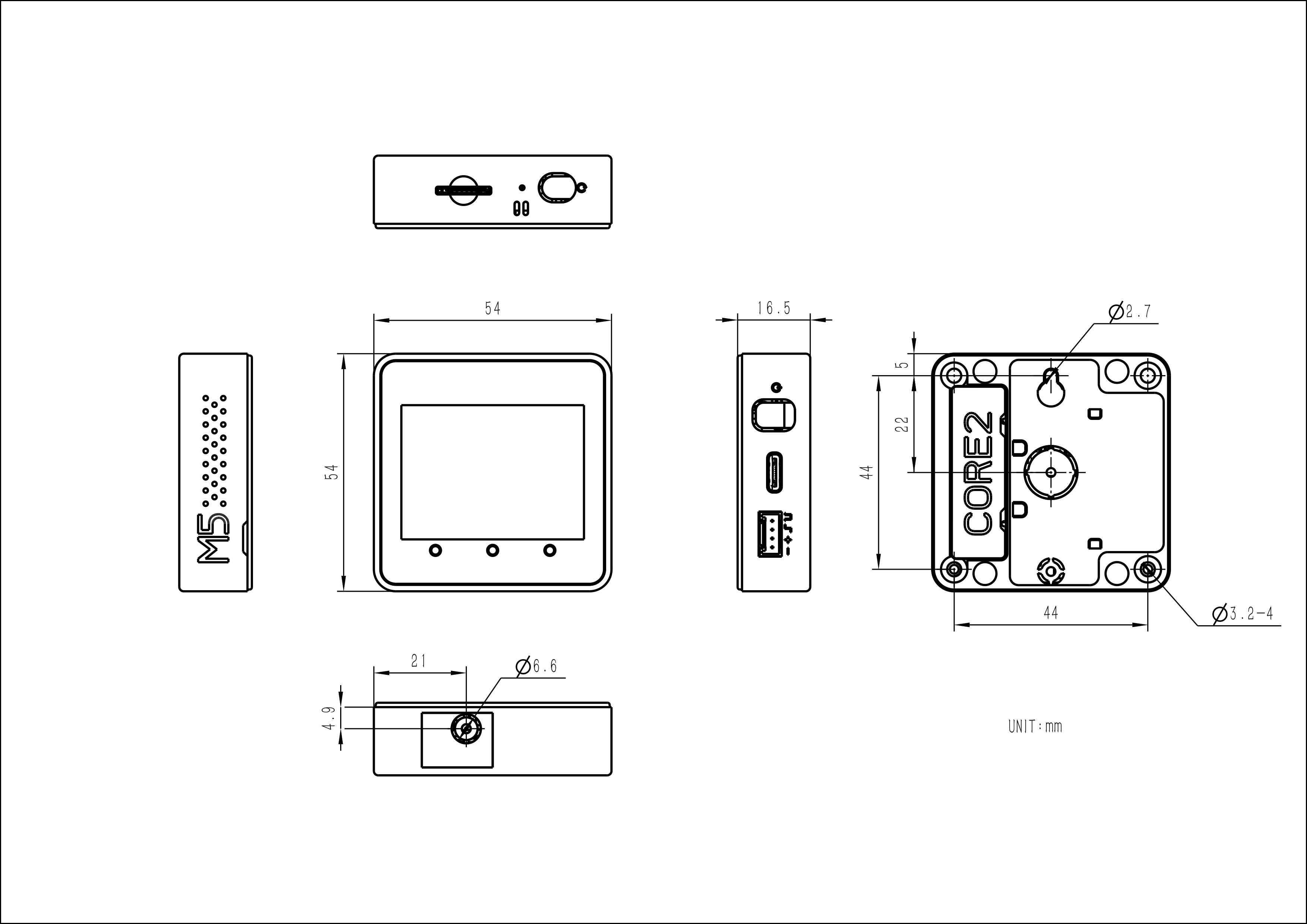
関連リンク
ソフトウェア
クイックスタート
Arduino
UiFlow1
UiFlow2
ESP-IDF
USB ドライバ
以下のリンクをクリックして、OS に合ったドライバをダウンロードしてください。現在、CP210X(CP2104版)/CP34X(CH9102版)ドライバ圧縮パッケージの 2 種類のドライバチップが存在します。圧縮パッケージを解凍後、インストールする OS の数に応じたインストールパッケージを選択してください。 (お使いのデバイスが使用している USB チップが不明な場合は、両方のドライバを同時にインストールすることができます。CH9102_VCP_SER_MacOS v1.7`のインストール中にエラーが発生することがありますが、実際にはインストールは完了していますので無視してください) 使用する際、もしプログラムが正常にダウンロードできない場合(プロンプトが overtime になったり、Failed to write to target RAM)は、デバイスドライバの再インストールを試してみてください。
| Driver name | Applicable driver chip | Download link |
|---|
| CP210x_VCP_Windows | CP2104 | Download |
| CP210x_VCP_MacOS | CP2104 | Download |
| CP210x_VCP_Linux | CP2104 | Download |
| CH9102_VCP_SER_Windows | CH9102 | Download |
| CH9102_VCP_SER_MacOS v1.7 | CH9102 | Download |
MacOS のポート選択
MacOS では、2 つの利用可能なポートが表示される場合があります。使用する際は、wchmodemという名前のポートを選択してください。
Easyloader
| Easyloader | Download | Note |
|---|
| Core2 Factory FirmWare | download | / |
その他
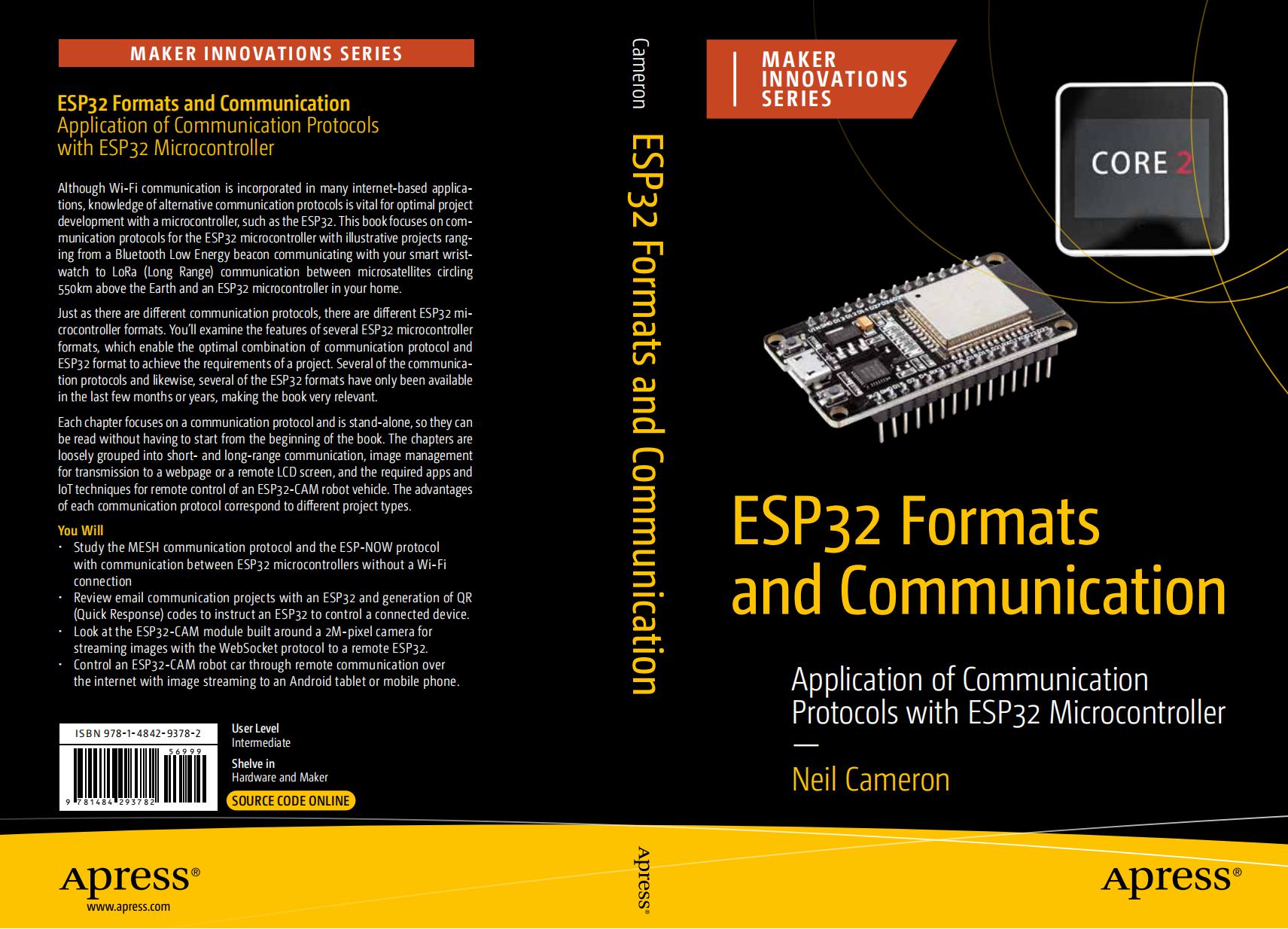
《ESP32 formats and communication protocols》一书分了几章介绍了 M5Stack Core2 模块。M5Stack Core2 模块集成了触摸 LCD 屏幕,蓝牙和 Wi-Fi 通信,麦克风和扬声器,以及加速度计和陀螺仪,使 M5Stack Core2 模块非常通用。本书使用通信协议构建项目,从将智能手表连接手机(BLE)到与地球上空环绕的卫星的远程通信(LoRa)以及设备之间的音频信号传输(I2S)。QR 码用于通过互联网控制外部设备,而 ESP-MESH 和 ESP-NOW 协议可在没有互联网连接的情况下实现微控制器之间的通信。
動画
製品比較
| Release Date | Product Change | Note: |
|---|
| 2020.6 | Initial public release< | / |
| 2021.7 | USB Chip changed from CP2104 to CH9102F | The actual delivery has two chip versions, CP2104/CH9102F, and there is no difference in function and use |
